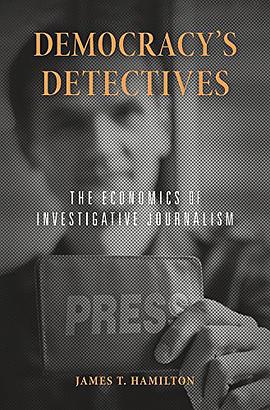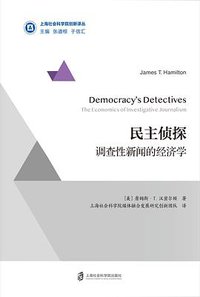Democracy's Detectives
豆瓣
The Economics of Investigative Journalism
James T. Hamilton
简介
In democratic societies, investigative journalism holds government and private institutions accountable to the public. From firings and resignations to changes in budgets and laws, the impact of this reporting can be significant—but so too are the costs. As newspapers confront shrinking subscriptions and advertising revenue, who is footing the bill for journalists to carry out their essential work? Democracy’s Detectives puts investigative journalism under a magnifying glass to clarify the challenges and opportunities facing news organizations today. Drawing on a painstakingly assembled data set of thousands of investigations by U.S. journalists, James T. Hamilton deploys economic theories of markets and incentives to reach conclusions about the types of investigative stories that get prioritized and funded.
Hamilton chronicles a remarkable record of investigative journalism’s real-world impact, showing how a single dollar invested in a story can generate hundreds of dollars in social benefits. An in-depth case study of Pulitzer Prize–winning reporter Pat Stith of The News and Observer in Raleigh, NC, who pursued over 150 investigations that led to the passage of dozens of state laws, illustrates the wide-ranging impact one intrepid journalist can have. Important stories are going untold as news outlets increasingly shy away from the expense of watchdog reporting, Hamilton warns, but technology may hold an answer. Computational journalism—making novel use of digital records and data-mining algorithms—promises to lower the costs of discovering stories and increase demand among readers.
contents
List of Tables*
Introduction
1. Economic Theories of Investigative Reporting
2. Detectives, Muckrakers, and Watchdogs
3. What’s the Story?
4. What’s the Impact?
5. How Is It Produced?
6. How Is It Supported?
7. A Single Investigative Reporter
8. Accountability and Algorithms
Notes
Acknowledgments
Index
* Tables
2.1. Principal-agent indices for newspaper content, by decade, 1870–1979
2.2. Ranking of principal-agent indices, within decades, 1870–1979
2.3. Circulation of McClure’s Magazine by population size and region, 1917
2.4. Distribution of journalism award citations across news outlets, 1918–2013
2.5. Production of journalism cited in awards, 1990–2013
2.6. Age and Pulitzer Prizes, 1918–2012
2.7. Media as sources of information in congressional hearings, 1946–2010
2.8. Product differentiation in network evening news, 1989–2012
3.1. Top story topics among IRE contest entries
3.2. IRE contest entries by entry type, medium, medium size, and decade
3.3. Policy agenda area coverage, 1980–2009, IRE contest entries vs. policy venues
3.4. Percentage of IRE contest entries within policy agenda area and focus, by medium
3.5. Policy agenda area and findings of IRE contest entries, by medium size, 1994–2010
4.1. Impacts of IRE contest entries, by medium
4.2. Impacts of IRE contest entries, by story finding
4.3. Impacts of ProPublica investigations, 2010–2012
4.4. Assessing the benefits and costs of investigative journalism: publishing, consuming, and policy impacts
4.5. Costs and benefits of investigative series, for first year of policy change
5.1. Production characteristics of IRE contest entries by medium
5.2. Production characteristics of IRE contest entries, by findings and impacts
5.3. Percentage of tip sheet author affiliations by organization type, by time period
5.4. Organizations with twenty or more IRE tip sheet author affiliations, 1987–2011
5.5. Timing and target of FOIA requests by type of media outlet, 2005–2010
5.6. Characteristics of FOIA requests by organizations with twenty or more requests, 2005–2010
6.1. News outlets and programs with fifty or more submissions to IRE contests
6.2. Change in IRE contest entries, 2006–2007 versus 2008–2009
6.3. Newspaper characteristics by IRE entry history
6.4. Newspaper characteristics by company ownership
6.5. Topics covered in IRE book list by authors associated with newspapers and magazines
6.6. Nonprofit donors and federal political contributions
6.7. 2012 election campaign contributions to Barack Obama and Mitt Romney by nonprofit media donors
7.1. Principal-agent problems in Change versus Dinger stories reported by Pat Stith
7.2. Organizations in North Carolina investigated, and time period of, Change versus Dinger stories reported by Pat Stith
7.3. Frequency distribution of types and impacts of Pat Stith stories
7.4. Relationship between principal-agent problems and impacts for stories by Pat Stith
7.5. Impacts on specific individuals generated by reporting of Pat Stith
7.6. Funds shifted or values affected because of reporting by Pat Stith
7.7. Laws in North Carolina generated by reporting of Pat Stith
7.8. Reactions to “North Carolina Water: Safe to Drink?”
7.9. Selected Pat Stith interview questions with Terry Pierce, director, Division of Environmental Health, NC Department of Environment and Natural Resources (DENR), February 7, 2006
